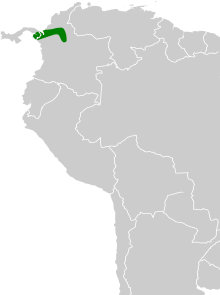| Black oropendola | |
|---|---|

| |
| Conservation status | |
 Least Concern (IUCN 3.1) | |
| Scientific classification | |
| Domain: | Eukaryota |
| Kingdom: | Animalia |
| Phylum: | Chordata |
| Class: | Aves |
| Order: | Passeriformes |
| Family: | Icteridae |
| Genus: | Psarocolius |
| Species: | P. guatimozinus |
| Binomial name | |
| Psarocolius guatimozinus (Bonaparte, 1853) | |

| |
The black oropendola (Psarocolius guatimozinus) is a species of bird in the family Icteridae (New World blackbirds). It is found in Colombia and Panama. Its natural habitat is subtropical or tropical moist lowland forests.
Description
The male black oropendola grows to a length of about 46 cm (18 in) and the female about 39.5 cm (15.6 in). The sexes are similar in appearance and are mainly black, with dark chestnut back, rump, part of the wing-coverts and crissum (the area around the cloaca). There is a bluish bare patch on the cheek, edged with pink at its lowest extremity, and an orange-tipped, black beak.
Distribution and habitat
The black oropendola is endemic to humid forests of northwestern South America. Its range includes northwestern Colombia, as far east as the Magdalena River, and the extreme southeastern part of Panama, a total area of occupancy of about 108,000 km (41,700 sq mi). Its altitudinal range is up to about 800 m (2,620 ft).
Ecology
The habits of the black oropendola have been little studied but its diet probably includes insects, small vertebrates and fruit. It clambers about high in the canopy and may sip nectar from flowers. It nests colonially, with up to twenty birds constructing their nests in one tree. The eggs are pale pink, scantily blotched with reddish brown. The black oropendola is probably polygynous, with one male mating with many females. The breeding season in Panama is February while in Colombia it is April to June.
Status
The black oropendola has a large range and is said to be fairly common. Its population trend seems to be stable and no particular threats have been identified. For these reasons, the International Union for Conservation of Nature has assessed its conservation status as being of "least concern".
References
- ^ BirdLife International (2020). "Psarocolius guatimozinus". IUCN Red List of Threatened Species. 2020: e.T22724025A136640257. doi:10.2305/IUCN.UK.2020-3.RLTS.T22724025A136640257.en. Retrieved 12 November 2021.
- ^ Ridgely, Robert S.; Tudor, Guy (2009). Field Guide to the Songbirds of South America: The Passerines. University of Texas Press. p. 678. ISBN 978-0-292-71748-0.
- ^ Fraga, R. (2011). "Black Oropendola (Psarocolius guatimozinus)". Handbook of the Birds of the World Alive. Lynx Edicions, Barcelona. Retrieved 10 September 2015.
- Hilty, Steven L.; Brown, Bill (1986). A Guide to the Birds of Colombia. Princeton University Press. p. 564. ISBN 0-691-08372-X.